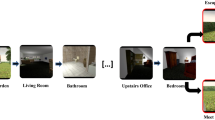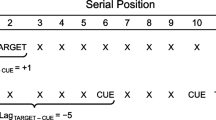Abstract
This study examined the effect of cue distinctiveness (presentation mode & valence) on event based prospective memory. It involved a 2 (positive, negative) x 2 (implicit, explicit) mixed design with repeated measure on the second factor. Cue (emotional & neutral words) learning preceded the ongoing task (vowel counting task). Participants (N = 40) made prospective memory response (press "p") to indicate cue occurrence during the ongoing task. Arial size 8 - gray on black at 120ms/word (implicit), - white on black at 250ms/word (explicit). Significant main effects of emotional valence and significant interaction between valence and modes of presentation was found. Post-hoc analysis revealed greater degree of accuracy for positive cues only during implicit presentations. The study concludes that cue valence functions as a measure of cue distinctiveness in event based prospective memory. Presentation modes particularly the implicit mode differentially benefits only the positive valence cue.


Similar content being viewed by others
References
Altgassen, M., Kliegel, M., & Martin, M. (2009). Event-based prospective memory in depression: the impact of cue focality. Cognition and Emotion, 23, 1041–1055.
Altgassen, M., Philips, L., Henry, J., Rendell, P., & Kliegel, M. (2010). Emotional target cues eliminate age differences in prospective memory. Quarterly Journal of Experimental Psychology, 63, 1057–1064.
Bauer, R. (1998). Physiological measures of emotion. Journal of Clinical Neurophysiology, 15, 388–396.
Bargh, J., & Morsella, E. (2008). The unconscious mind. Perspectives on Psychological Science, 3(1), 73–79.
Bernat, E., Bunce, S., & Shevrin, H. (2001). Event-related brain potentials differentiate positive and negative mood adjectives during both supraliminal and subliminal visual processing. International Journal of Psychophysiology, 42, 11–34.
Bechara, A., Tranel, D., Damasio, H., Adolphs, R., Rockland, C., & Damasio, A. (1995). Double dissociation of conditioning and declarative knowledge relative to the amygdala and hippocampus in humans. Science, 269, 1115–1118.
Bradley, M., & Lang, P. (1999). Affective norms for english words (ANEW): Instruction manual and affective ratings, Technical Report C-1, The Center for Research in Psychophysiology, University of Florida.
Bunce, S., Bernat, E., Wong, P., & Shevrin, H. (1999). Further evidence for unconscious learning: preliminary support for the conditioning of facial EMG to subliminal stimuli. Journal of Psychiatric Research, 33, 341–347.
Clark-Foos, A., Brewer, G., Marsh, R., Meeks, J., & Cook, G. (2009). The valence of event-based prospective memory cues or the context in which they occur affect their detection. American Journal of Psychology, 122, 89–97.
Damasio, A. (1994). Descartes' error. New York:Putnam.
Dobbs, A., & Reeves, M. (1996). Prospective memory: More than memory. In M. Brandimonte, G. Einstien, & M. McDaneil (Eds.), Prospective Memory: Theory and Applications (pp. 199–225). Hillsdale, NJ: Erlbaum.
Eimer, M., & Schlaghecken, F. (2003). Response facilitation and inhibition in subliminal priming. Biological Psychology, 64(1–2), 7–26.
Epstein, S. (1994). Integration of the cognitive and the psychodynamic unconscious. American Psychologist, 49, 709–724.
Esteves, F., Parra, C., Dimberg, U., & Ohman, A. (1994). Nonconscious associative learning: pavolvian conditioning of skin conductance responses to masked fear-relevant facial stimuli. Psychophysiology, 31, 375–385.
Hansen, C., & Hansen, R. (1988). Finding the face in the crowd: an anger superiority effect. Journal of Personality and Social Psychology, 54, 917–924.
Hashimoto, T., Umeda, S., & Kojima, S. (2011). Neural substrates of implicit cuing effect on prospective memory. NeuroImage, 54, 645–652.
Henke, K. (2010). A model for memory systems based on processing modes rather than consciousness. Nature Reviews Neuroscience, 11(7), 523–532.
Izard, C. (1993). Four systems for emotion activation: cognitive and non-cognitive processes. Psychological Review, 100, 68–90.
Kihlstrom, J. (1987). The cognitive unconscious. Science, 237, 1445–1452.
Kunst-Wilson, W., & Zajonc, R. (1980). Affective discrimination of stimuli that cannot be recognized. Science, 207, 557–558.
Lang, P., Greenwald, M., Bradley, M., & Hamm, A. (1993). Looking at pictures: affective, facial, visceral, and behavioral manifestations. Psychophysiology, 30, 261273.
Lazarus, R. (1991). Cognition and motivation in emotion. American Psychologist, 46, 352–367.
LeDoux, J. (1989). Cognitive–emotional interactions in the brain. Cognition and Emotion, 3(4), 267–289.
McDaniel, M., & Einstein, G. (2000). Strategic and automatic processes in prospective memory retrieval: a multiprocess framework. Applied Cognitive Psychology, 14, 127–144.
Merikle, P., & Smith, S. (2005). Memory for information perceived without awareness. In N. Ohta, C. M. Macleod, & B. Uttl (Eds.), Dynamic cognitive processes (pp. 79–99). Tokyo: Springer-Verlag.
Meneguzzo, P., Tsakiris, M., Schioth, H., Stein, J., & Brooks, S. (2014). Subliminal versus supraliminal neural responses in anterior cingulate cortex, fusiform gyrus and insula: a meta-analysis of fMRI studies. BMC Psychology, 2, 52.
Miller, G. (1996). How we think about cognition, emotion, and biology in psychopathology. Psychophysiology, 33, 615–628.
Morris, J., Ohman, A., & Dolan, R. (1998). Conscious and unconscious emotional learning in the human amygdala. Nature, 393, 467–470.
Mogg, K., Bradley, B., Williams, R.., & Mathews, A. (1993). Subliminal processing of emotional information in anxiety and depression. Journal of Abnormal Psychology, 102, 304–311.
Murphy, N., & Isaacowitz, D. (2008). Preferences for emotional information in older and younger adults: a meta-analysis of memory and attention tasks. Psychology and Aging, 23, 263–286.
Muscarella, C., Brintazzoli, G., Gordts, S., Soetens, E., & Van den Bussche, E. (2013). Short and long term effects of conscious, minimally conscious and unconscious brand logos. PloS One, 8, e57738.
Ochsner, K., Silvers, J., & Buhle, J. (2012). Functional imaging studies of emotion regulation: a systematic review and evolving model of the cognitive control of emotion. Annals of the New York Academy of Sciences, 1251, E1–E24.
Ohman, A., Lundqvist, D., & Esteves, F. (2001). The face in the crowd revisited: threat advantage with schematic stimuli. Journal of Personality and Social Psychology, 80, 381–396.
Ohman, A., Esteves, F., & Soares, J. (1995). Preparedness and pre-attentive associative learning: electrodermal conditioning to masked stimuli. Journal of Psychophysiology, 9(2), 99–108.
Pratto, F., & John, O. (1991). Automatic vigilance: the attention-grabbing power of negative social information. Journal of Personality and Social Psychology, 61, 380–391.
Pierce, C., & Jastrow, J. (1884). On small differences in sensation. Memoirs of the National Academy of Science, 3, 75–83.
Rauch, S., Whalen, P., Shin, L., McInerney, S., Macklin, M., Lasko, N., Orr, S., & Pitman, R. (2000). Exaggerated amygdala response to masked facial stimuli in posttraumatic stress disorder: a functional MRI study. Biological Psychiatry, 47, 769–776.
Rendell, P., Phillips, L., Henry, J., Brumby-Rendell, T., Piedad Garcia, X., Altgassen, M., & Liegel, M. (2011). Prospective memory, emotional valence & aging. Cognition and Emotion, 25(5), 916–925.
Rude, S., Hertel, P., Jarrold, W., Covich, J., & Hedlund, S. (1999). Depression related impairments in prospective memory. Cognition and Emotion, 13, 267–276.
Russell, J. (1978). Evidence of convergent validity on the dimensions of affect. Journal of Personality and Social Psychology, 36, 1152–1168.
Shalgi, S., & Deouell, L. (2013). Is there any electrophysiological evidence for subliminal error processing? Frontiers in Neuroscience, 7, 150.
Shevrin, H., & Fritzler, D. (1968). Visual evoked response correlates of unconscious mental processes. Science, 161, 295–298.
Shevrin, H., & Dickman, S. (1980). The psychological unconscious, a necessary assumption for all psychological theory? American. Psychologist, 35, 421–435.
Shevrin, H., Bond, J., Brakel, L., Hertel, R., & Williams, W. (1996). Conscious and unconscious processes: Psychodynamic, cognitive, and neurophysiological convergences. New York:Guilford Press.
Turk-Browne, N., Yi, D., Leber, A., & Chun, M. (2007). Visual quality determines the direction of neural repetition effects. Cerebral Cortex, 17, 425–433.
Tsushima, Y., Sasaki, Y., & Watanabe, T. (2006). Greater disruption due to failure of inhibitory control on an ambiguous distractor. Science, 314, 1786–1788.
Watson, D., Anna Clark, L., & Tellegen, A. (1998). Development and validation of brief measures of postive and negative affect: The PANAS scales. Journal of Personality and Social Psychology, 54, 1063–1070.
Whalen, P., Rauch, S., Etcoff, N., McInerney, S., Lee, M., & Jenike, M. (1998). Masked presentation of emotional facial expressions modulate amygdala activity without explicit knowledge. Journal of Neuroscience, 18, 411–418.
Wong, P., Shevrin, H., & Williams, W. (1994). Conscious and nonconscious processes: an ERP index of an anticipatory response in a conditioning paradigm using visually masked stimuli. Psychopsysiology, 31, 87–101.
Wong, P., Bernat, E., Bunce, S., & Shevrin, H. (1997). Brain indices of nonconscious associative learning. Consciousness and Cognition, 6, 519–544.
Yang, J., Xu, X., Du, X., Shi, C., & Fang, F. (2011). Effects of unconscious processing on implicit memory for fearful faces. PloS One, 6(2), e14641.
Author information
Authors and Affiliations
Corresponding author
Rights and permissions
About this article
Cite this article
Singh, T., Kashyap, N. Effect of Cue Characteristics on Event Based Prospective Memory: Evaluating Valence and Presentation Mode. Psychol Stud 61, 13–20 (2016). https://doi.org/10.1007/s12646-015-0331-9
Received:
Accepted:
Published:
Issue Date:
DOI: https://doi.org/10.1007/s12646-015-0331-9




